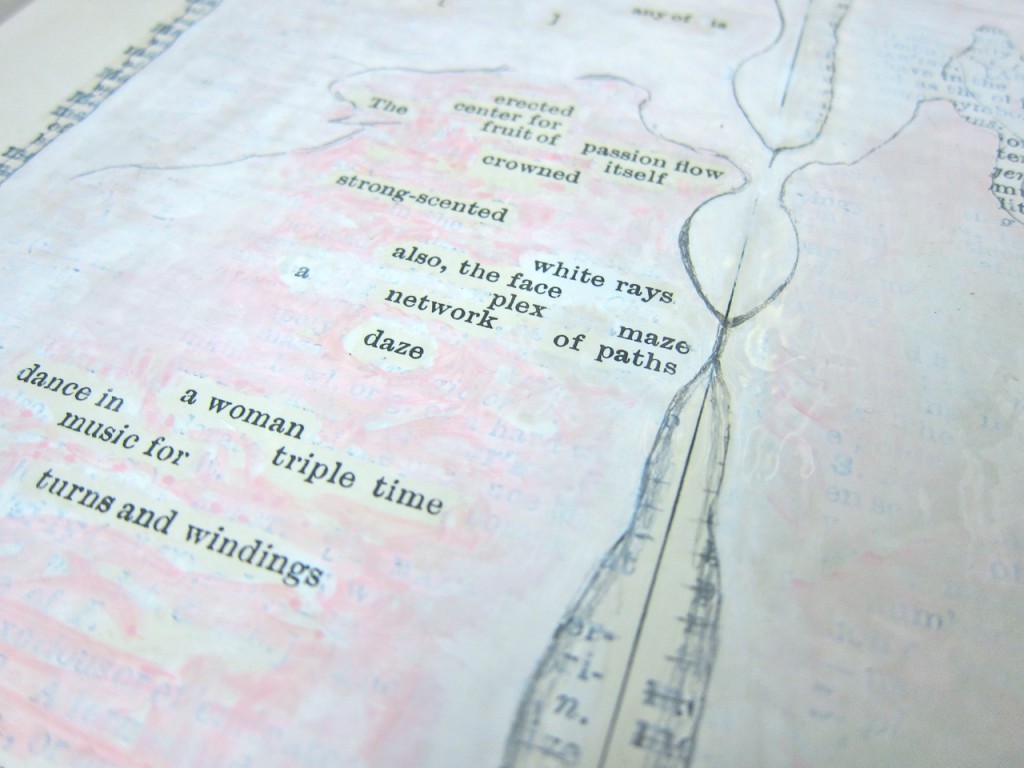
Over at the Marfa Book Company, where there is a beautiful gallery space—and where they’ve exhibited works by Robert Grenier, Roni Horn, Rosa Barba, Luis Camnitzer, Nicolas G. Miller, among other artists—Tim Johnson and Caitlin Murray (bookstore owners, poets, curators, book-makers, art and literary historians . . . I would be amiss to paint upon these Shorthorn fans any suit or resting face) are gearing up for a show by: Doris Cross. A name new to me, I spent the morning trolling around the Internet . . . bits and pieces of Cross floated up from that inimitable ether, but none so surprising as the discovery that the Wikipedia entry on “Erasure” cites Cross as the “earliest to use this technique, beginning in 1965 with her Dictionary Columns.” It links no entry to her name, but goes on to list our usual suspects in this category: Ronald Johnson (Radi Os), Jen Bervin (Nets), Jenny Holzer (Redaction Paintings), etc. Frustrated by the paltry, nearly non-existent paper trail on Cross, I brought my questions to Tim. And what began as a conversation about Cross quickly became a conversation—with and through Cross—about personhood, poetry, painting, Tim’s own work, the Reading Room, and the vagaries of artistic practice in general. Images of Cross's work henceforth scattered (dates and titles yet unknown) were taken by Tim while visiting her archives some weeks back. Here is what we said:
Lynn: Let's talk about Doris Cross. From what I can find on the Internet, which is very little, she was born in 1907 and died in 1994. She studied with Hans Hofmann and was friends with Robert Motherwell and all the European artists he brought to New York in the 1940s, and then settled in Santa Fe in 1972. Can you fill out this scene a bit more—give us a sense of her world?
Tim: Well, I must admit that I'm also at the beginning of my familiarity with Doris Cross, which is part of what's so interesting about this exhibition Caitlin and I are planning. When we were introduced to her work (through our friendship with her grandson, James Rodewald) we basically couldn't understand how we'd never heard of her. In addition to all you've mentioned, she also studied at the Art Students League from 1940 to 1943; she taught at a number of art schools in the 60s, including the Aspen School of Contemporary Art; she made a film in the late 60s; she made several collaborative videos with Steina and Woody Vasulka; she lived for a while in upstate New York; and she was the first living woman to have a solo exhibition at the Museum of Fine Arts in Santa Fe. So, she was active, was familiar with many of the prominent artists of her era, and also enjoyed some notoriety in her lifetime.
At the same time, I recall a statement she made in an interview about living in Santa Fe where she says many people dismissed her as "the dictionary artist" and "conceptualist." However, even the date of her earliest "column" works, which are the ones we're exhibiting, is uncertain to me at this point, though it seems that a date around 1965 is likeliest. These works, which begin with pages she reproduced from the 1913 Webster's Dictionary, Secondary School Edition, are characterized by a great many different surface treatments, among them: overpainting in a variety of colors and of various levels of opacity and translucency; enlargement; positive and negative transfer; collage; classic black-line redaction and also, erasure. These are decidedly verbo-visual works, and their inclusion of erasure and redaction, seem to be both very early and very intriguing examples of this mode, especially when we consider that Tom Phillips and Ronald Johnson, two of the poets we most closely associate with this mode, published their works after Cross had established her version.

Lynn: I found an interview she did in 1981 and, in it, she talks about her work with dictionaries and language. There is something incredibly hermetic about her creative process and, perhaps, a stubbornness of contact with her materials? How would you describe what she does and what interests you most about it?
Tim: Well, "hermetic" is an interesting word for Doris Cross, but I'll address that in a moment. Firstly, I was taken by the sheer number of ways she treats the same few pages she chose to work with over several decades. I don't have an accurate count at present, but it seems she worked and reworked around forty or fifty individual columns from the pages of this same dictionary. Unlike Ronald Johnson, for instance, who reveals a single poem in Radi Os, Cross is making variations on the same "original" text over many years. Plus, of course, she has chosen the dictionary, the site of linguistic concretization, to make her multiple, unique works. There's a destabilization that happens simultaneously with a re-stabilization in the new work. And yet, she's also pointing to the possibility of other texts within. For instance, in one work, she has made a triptych out of three different treatments of photostat reproductions of the same dictionary column. Additionally, she disorients us further by making a great play of the illustrations that were already present in the dictionary itself. So, even in what is ostensibly the Word's most stable instantiation, we've got these non-linguistic representations.
To get back to the hermetic, at points there's a sense of secret texts being discovered and delivered to the viewer, as though the dictionary were this vast, coded document. Plus, she incorporates her skills as a painter, and I'd particularly emphasize her familiarity with the rectangular color fields that we find in Hoffman's paintings, to create works of singular visual activity.

Lynn: In this same interview, when the interviewer says that in Cross's work she is “making connections” she says, so confidently: “That’s what I’m doing, making connections, not writing poetry.” This rejection of writing is very powerful don’t you think? I mean, I am so unclear about what writing is, what poetry is—I am so happy in this swampy lake of indecision—that when someone is so clear about their practice as being this, or not this . . . I really want to know: what it is that allows her to have this kind of conviction?
Tim: I want to respect her designation, but perhaps by writing she's thinking of inscription? While she's making a great number of marks, she doesn't to my knowledge, add any of "her own" words. I add those scare quotes since there still remains an air of uncertainty about this practice. But, more importantly, for Doris Cross, it's a process of selection. In the same quote, she mentions that one day, without a great familiarity with literature, she observed that the dictionaries she collected featured two columns per page and that each column had a word centered above it. Those words were the first and last words on that page. On the top of one of these pages she read, "lamb" and "laceration." She characterizes that combination is "like literature" but not literature itself.
For me, that combination reminds me of Ian Hamilton Finlay's practice of the One Word Poem which, curiously, always contained at least two words, one each for the body of the poem and its title. There's an activity of signification that begins in combination and for some, that's the ground for a lot of poetry. I experience these two ideas as quite similar, minus the question of invention, where the words came from and so forth. But, honestly, I don't think any of us can speak with any certainty about the ontology of these vast areas of practice and discourse, such as poetry or painting.
And because it's not available on the internet at present and because it gives us another view, perhaps I could add this quote, from an interview between Doris Cross and Geraldine Price, conducted in 1973 and published in Southwest Art:
I am not involved with design. I am just involved with the idea of leaving things—In this case, words, where they are found. But the reason I feel this is way is that everything is here; it is only to be seen and found. We are surrounded with everything. You become the center, and you reach out. And when you do reach out—it is almost a physical action and a visual action—you can embrace what you see and make your choices for placement, meaning, or whatever you can possibly give it. In the whole of one's life one can become the focal point and receive the found material—it is an open approach.
Lynn: This question is about you and your own work:

I remember talking to you in the winter, standing there, in the kitchen, you trying to explain this new thing you were working on, and me, two glasses into the Côtes du . . . and listening hard, trying to follow the various hiccups of media . . . but in the end, you said: it is a poem, or, it is poetry. For the same reason I am struck by Cross’s rejection of poetry I was struck by your confidence that poetry (as a world and as a practice, both conceptually and historically) is where your work belongs. Can you talk about this?
Tim: Tricky question, though it's probably obvious that I'm likeliest to talk about my work in that way in those kinds of situations. A little out of focus. But, I do think about a painter friend who told me she thinks of her work as growing increasingly connoisseurial with time, that it's a function of coming to know paint and coming to know painting. In this way, there's a tradition we work with, and sometimes against, and our intimacy with that tradition is in some ways the medium in which we work. I'll also add that she said this to me right before introducing me to a new painting that features a lot of words! Of course, she can just say, "Stuart Davis," if she wants and be done with it. Which is totally great.
My work derives from my love of poetry, of making poems since I was a teenager. The work I make now is what I make after all the other work I made. Although there have definitely been periods, even years when I felt lost and didn't know whether I was doing anything at all, sometimes it feels coherent to me. Plus, my work is often some kind of tribute or attempt to respond to another poet. And, for me, whatever the mode of instantiation, it's always the words that motivate me, even if it's the title's relation to a wordless object, if such a thing can be said to exist. Some of the works make obvious connections with previous works by other poets. I suppose this is a little like a musician quoting a passage by another, earlier musician in the body of a new work. There's a kind of solidarity that's being established there. And I dig that. No matter how frustrated I get with poems, and by this I mean my own and everyone else's, I keep coming back.
Lynn: Finally, as bookstore owners and curators (for the gallery and for the events space)—what really gets you and Caitlin excited these days?
Tim: Probably the biggest thing we're working on right now is Reading Room. A few years ago my girlfriend, Caitlin, decided that our pretty large library, which includes all our books, many of which are poetry titles, and the books she inherited from her father who was a history professor, would be best used if we made them available to the public. So, she established a small library called Reading Room. It was a rogue at first, not exactly a non-profit, because we simply wanted to test its nature. Initially we rented one half of a small house here in Marfa and then, after about a year, we moved Reading Room to another location, also small, but nonetheless quite comfortable, in the main building of a local hotel. And now, after about three years, we've merged with the local nonprofit that operates our community theater, the Crowley Foundation, and together we've bought a small house where we hope to expand the collection and services provided by the project. The idea is to make a site that emphasizes the significance of the quiet and yet public life that reading rooms afford. Also, its collection will respond to the various histories that are co-present in this region. Plus, we'll have a garden. That's a source of enthusiasm for us.
Otherwise, we're about to print the second edition of a work by Robert Grenier entitled 16 from R H Y M M S, which is something we're very proud of. Concerning other poets and artists, like a lot of people, we're into Future Islands. The new Wye Oak record is also great. Anything by Mark So. Caitlin has been spending a lot of time with Brecht's work. And she recently finished a master's thesis on Carl Andre's poems. We've also had the chance to read and see the new body of work that Susan Howe presented at an exhibition at Yale Union last year and it's marvelous. I can't wait to see that in book form. Caroline Bergvall's new book, Drift, also. Plus, let's not forget, Gorgeous Nothings was just published. There are many reasons to be excited.
Born in Shanghai, poet Lynn Xu earned a BA from the University of California at Berkeley and an MFA ...
Read Full Biography

